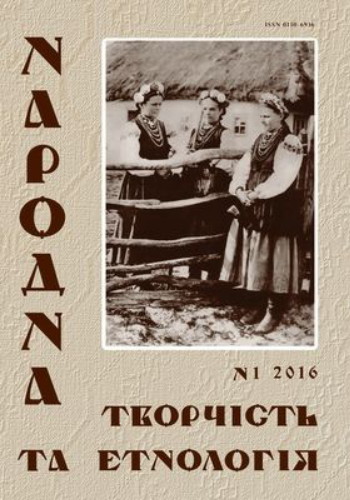Institute of Fine Arts, Folklore, and Ethnology of the National Academy of Sciences of Ukraine
Institute of Fine Arts, Folklore, and Ethnology of the National Academy of Sciences of Ukraine [Інститут мистецтвознавства, фольклору та етнології ім. М.Т. Рильського Національної академії наук України; Instytut mystetstvoznavstva, folkloru ta etnolohii im. M.T. Rylskoho Natsionalnoi akademii nauk Ukrainy]. A leading scientific research institute in Ukraine. Founded in 1936 as the Institute of Ukrainian Folklore, it replaced the abolished Ethnographic Commission of the All-Ukrainian Academy of Sciences, Cabinet of Anthropology and Ethnology, Cabinet of Musical Ethnography, Cabinet of Primitive Culture, Chair of Ukraine’s History, and Commission for Historical Songs. Some of these had been incorporated into the new Institute of the History of Material Culture (1934–8), which had its own folkloristic-ethnographic section with a museum and cabinet of musical ethnography (headed by V. Kharkiv).
The Institute of Ukrainian Folklore had three sectors: oral folklore, headed by M. Nahorny (1937–9) and M. Pavlii (1939–41); musical folklore, headed by Mykhailo Haidai (1936–7), Pylyp Kozytsky (1937–8), and Mykola Hrinchenko (1938–41); and financial resources. Its first director was the former deputy commissar of education, Andrii Khvylia. He was replaced in 1939 by Yurii M. Sokolov, who was brought in from Moscow University and elected a full member of the Academy of Sciences of the Ukrainian SSR. In the prewar Stalinist period its main focus was the collection and study of new ‘Soviet’ folklore and providing assistance to those who created it. Folk tales, legends, myths, and other traditional folk genres were deemed ‘vestiges of capitalism.’
After the Soviet occupation of Galicia, in November 1939 a branch of the institute was created out of the abolished Ethnographic Commission of the Shevchenko Scientific Society and headed by Filaret Kolessa. After the outbreak of the German-Soviet War, in July 1941 the institute was evacuated to Ufa, Bashkiria, where it was reduced to a department of the Institute of Social Sciences with a staff of two. In June 1942 the Institute of Folk Creativity and Art was formed there under the directorship of Mykola Hrinchenko and, after his death in November, Maksym Rylsky.
From August 1943 to March 1944 the institute operated from Moscow, and in March 1944 it was substantially reorganized and re-established in Kyiv under the name Institute of Fine Arts, Folklore, and Ethnography of the Academy of Sciences of the Ukrainian SSR. Maksym Rylsky remained its director until his death in 1964, when the institute was named in his honor. His successors were Mykola Syvachenko (1964–73) and Serhii Zubkov (1974–87). In 1982 a branch of the institute was created in Lviv out of the Ukrainian State Museum of Ethnography and Crafts; its first director was Yurii Hoshko. Between 1987 and 2000 the institute was directed by Oleksandr Kostiuk, under whose directorship it reorganized and assumed its present name in 1994. Since 2000 the director of the institute has been Hanna Skrypnyk.
During the Soviet period, the institute’s policies and research were largely subject to non-scholarly, Soviet political considerations; this bias was reflected in many of its publications. In accordance with Soviet nationality policy, the institute promoted and published research on the Ukrainian arts and ethnography in the context of interethnic relations in the USSR and the Soviet bloc and their mutual ‘enrichment’ and ‘internationalization.’ Emphasis was placed on the study of working-class culture, historical ethnography, the culture and folkways of the inhabitants of the Carpathian Mountains, and museology. Its most important project was a 35-volume series Ukraïns’ka narodna tvorchist’ (Ukrainian Folk Creativity), of which 27 volumes were published between 1961 and 1991.
In independent Ukraine after 1991 the institute’s primary fields of research have been history and ethnography of Ukrainian culture; history and theory of professional and folk arts; and folklore and folk arts of foreign countries. The institute’s scholars have conducted extensive folkloric and ethnographic research in various parts of Ukraine and also compiled an electronic database of Ukraine’s ethnic cultures. Among the most significant collective works published by the institute are: Istoriia ukraïns’koho radians’koho kino (A History of Soviet Ukrainain Cinema, 3 vols, 1986); Istoriia ukraïns’koï muzyky (A History of Ukrainian Music, 4 vols, 1989–92); Slovians’ka fol’klorystyka. Narysy rozvytku. Materialy (Slavic Folklore: A Survey of Development. Materials, 1987); Istoriia ukraïn’skoho mystetstva (A History of Ukrainian Art, 4 vols, 2007–11); Istoria ukraïns’koho teatru (A History of Ukrainian Theater, 3 vols, 2009); Istoriia dekoratyvnoho mystetstva Ukraïny (A History of Decorative Arts of Ukraine, 4 vols, 2010–11); Istoriia ukraïn’skoho kino (A History of Ukrainian Cinema, 2 vols, 2016); and others.
Today the institute consists of the Ukrainian Ethnological Center and four departments: visual, decorative, and applied arts; Ukrainian and foreign folklore; musicology and ethnomusicology; cinema and theater arts and cultural studies. The institute’s manuscript collection contains more than 20 thousand items. Regional branches of the institute are located in Mykolaiv, Khmelnytskyi, Kherson, and Sloviansk. The institute is the basis for the International Association of Ukrainian Ethnologists. In 2010, among 137 scholarly associates of the institute was one full member of the National Academy of Sciences of Ukraine (NANU) (Hanna Skrypnyk), five corresponding members of the NANU (Tetiana Kara-Vasylieva, Valentyna Ruban, Nelli Korniienko, Alla Tereshchenko, and Ihor Iudkin), one full member of the Academy of Pedagogical Sciences of Ukraine (Dmytro Stepovyk), 19 doctors of sciences, and 57 candidates of sciences.
In the early years of its existence the institute published the periodicals Ukraïns’kyi fol’klor (1937–9), Narodna tvorchist’ (1939–41). In 1957 it started publishing its main periodical Narodna tvorchist’ ta ethnohrafiia which was renamed Narodna tvorchist’ ta etnolohiia in 2011. Other periodicals and publication series of the institute have included Materialy do ukraïn’skoï etnolohiï (17 vols, 1995–2015); Naukovi studiï IMFE (2 vols, 2012–13); Ukraïns’ke mystetstvoznavstvo (15 vols, 2004–15); Slovians’kyi svit (14 vols, 1997–2015); and Studiï mystetstvoznavchi (54 vols, 2002–16).
(See also Art studies and research, Ethnography, Musicology, and Theater studies.)
Serhiy Bilenky, Mykola Mushynka
[This article was updated in 2017.]

